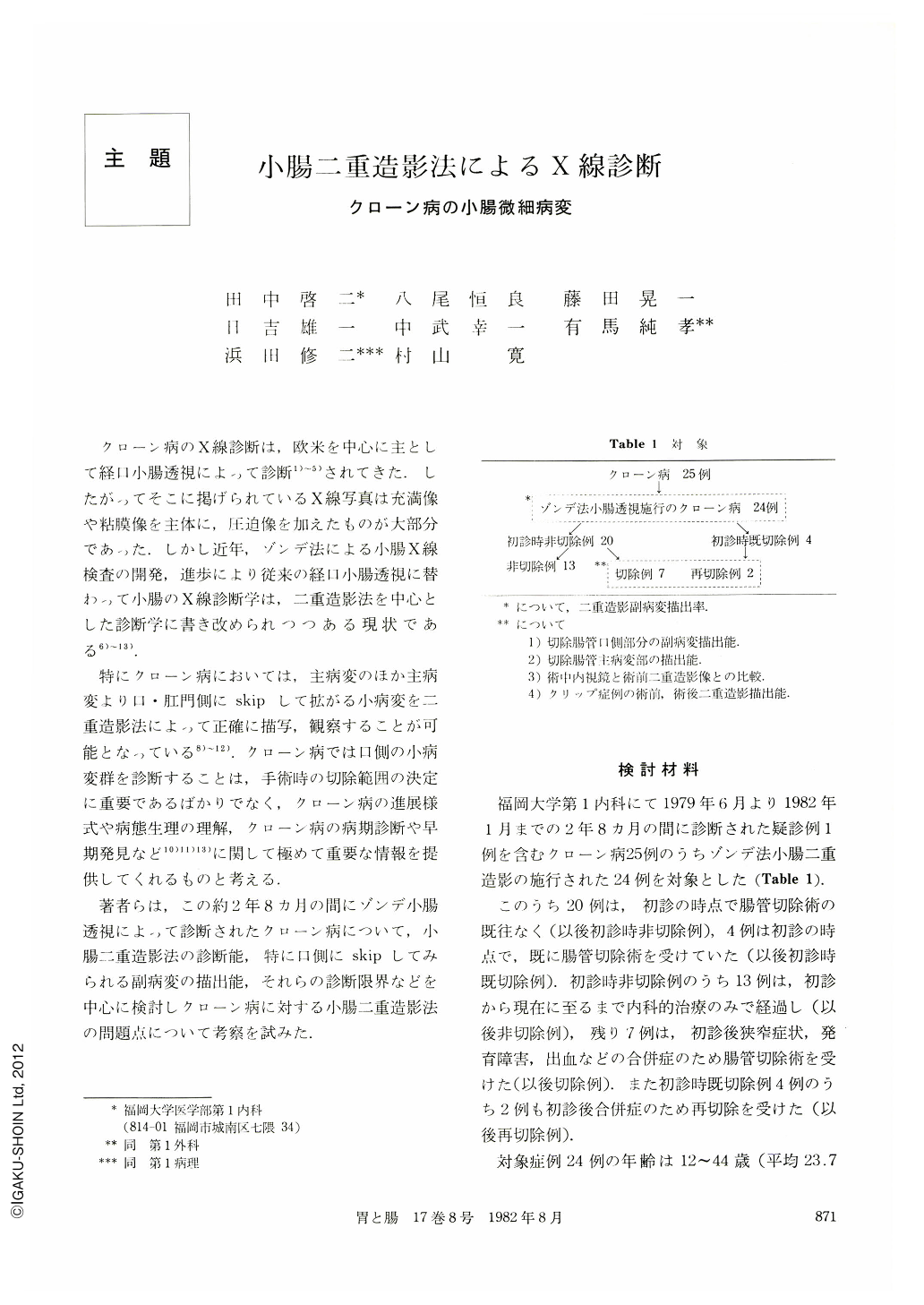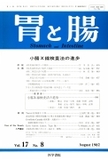Japanese
English
- 有料閲覧
- Abstract 文献概要
- 1ページ目 Look Inside
- サイト内被引用 Cited by
クローン病のX線診断は,欧米を中心に主として経口小腸透視によって診断1)~5)されてきた.したがってそこに掲げられているX線写真は充満像や粘膜像を主体に,圧迫像を加えたものが大部分であった.しかし近年,ゾンデ法による小腸X線検査の開発,進歩により従来の経口小腸透視に替わって小腸のX線診断学は,二重造影法を中心とした診断学に書き改められつつある現状である6)~13).
特にクローン病においては,主病変のほか主病変より口・肛門側にskipして拡がる小病変を二重造影法によって正確に描写,観察することが可能となっている8)~12).クローン病では口側の小病変群を診断することは,手術時の切除範囲の決定に重要であるばかりでなく,クローン病の進展様式や病態生理の理解,クローン病の病期診断や早期発見など10)11)13)に関して極めて重要な情報を提供してくれるものと考える.
A study has been made of how well the double contrast study of the bowel can depict the chief lesions in Crohn's disease and secondary lesions that skipped orally from the chief ones and of the points at issue of the double contrast method. Our subjects of study have been 24 patients with Crohn's disease of the small intestine diagnosed in the recent two and eight months by double contrast method of the small intestine including a patient suspected as such by it. The secondary lesions were defined as those impossible to point out from the serosal side at laparotomy and those non-resected were defined as those small lesions similar to the above.
The number of the subjects studied was 24, ranging from 12 to 44 years old ; the mean age was 23.7 and the male outnumbered the female in a ratio of 15: 9. The rate of well described secondary lesions as defined above was sought. In nine operated patients preoperative double contrast pictures of chief lesions and oral secondary lesions were compared with pictures of double contrast study in the resected specimens as well as double contrast study of the excised specimen and endoscopic pictures during the operation. Clips were left behind in four patients operated on in the mesentery near the secondary lesions observed endoscopically during the surgical resection. After the operation double contrast pictures of the bowel were taken with the clips as landmark, of changes. Pictures before and after the operation were studied for the purpose of comparing the descriptive capability of each method.
The results obtained were as follow:
1. We were able to classify into five types of x-ray findings of secondary lesions in Crohn's disease. Above all, aphthoid ulcers were found even in small ones as compared with those reported in the literature. We considered them the smallest secondary lesions in Crohn's disease.
2. The secondary lesion, as defined above were depicted by the double contrast method of the small intestine in a very high rate: 21 patients out of 24 or 87.5%.
3. When we compared excised specimens in patients with resected or re-resected bowel with findings of preoperative double contrast study or double contrast study of resected specimens or endoscopic pictures during operation the results were unsatisfactory. Their causes and measures to be taken are considered as follows:
1) In most cases of Crohn's disease the stricturelike chief lesions are seen in the terminal ileum, distal small intestine or the colon, so that the contrast medium takes far more time than usual in reaching the cecum. As a result, the oral and middle part of the small bowel are not so well visualized.
2) For obtaining good double contrast pictures of the upper and middle part of the small intestine one should take such pictures apart from those double contrast pictures aiming at the upper and middle part of the small intestine.
3) As in patients to whom operation look like inevitable, most of secondary lesions could not be found from the serosal side, we have stressed that it is very important to consider the fact that upper and middle part of the small intestine should be regarded sepa-rately from the lower part of the small bowel.
4) In patients with resected bowel, we have studied how well the chief lesions were depicted. In parts they were visualized well and one could not be at a loss to diagnose Crohn's disease, but as a whole the depicted findings were unsatisfactory.
5) At the endoscopic observation during the surgical intervention, we left clips in the mesentery near the secondary lesions. The resected segment was studied in double contrast method for the purpose of studying the diagnostic limit of secondary lesions.

Copyright © 1982, Igaku-Shoin Ltd. All rights reserved.


